How to price cleaning service right
Wed, Jun 26, 2024
Read in 10 minutes

Pricing your cleaning services correctly is crucial for attracting clients and ensuring profitability. Whether you’re offering commercial cleaning services or residential cleaning services, understanding how to set competitive and fair prices is essential. No matter where you are in the business growth, deciding the pricing of services can be tricky. Finding the perfect balance between retaining clients and making profits. If you keep the price too high, you lose the client but if the price is too low, then you lose profits.
The main aim of the blog will be to give commercial cleaning service providers enough knowledge so that they can give fair and competitive pricing. But also maintain a profitable cleaning business. This guide will help you navigate the process with clear and simple steps.
How to Price Your Cleaning Service Right
Pricing your cleaning service involves more than just picking a number. You need to consider various factors to ensure your rates are fair and competitive.
1. Understand Your Costs
Start by calculating all your expenses, both fixed and variable. This includes costs for cleaning supplies, equipment, transportation, labor, insurance, and marketing. Knowing your total costs is the foundation for setting your prices. This includes both fixed and variable expenses.
• Fixed Costs: These are expenses that remain constant regardless of the number of jobs you take. Examples include rent, insurance, and utilities.
• Variable Costs: These costs vary depending on the number of jobs or hours worked. Examples include cleaning supplies, transportation, and labor costs.
2. Understand the Pricing Models
Hourly Rates
They are the most commonly used pricing model to calculate the price of any cleaning job. They provide flexibility to both the service providers and clients as well. For instance, a cleaning business might charge between $25 to $45 per hour for a standard house cleaning service. This can vary depending on location, time, and the type of services required. The clients like this better because they will be only paying for the actual time spent cleaning the area.
• Flat Fee
This offers simplicity to the clients as it lets them know the cleaning services prices beforehand. The clients do not have to worry about the total time spent on the job and what will be the end cost. For example, a cleaning business might offer a flat fee of $100 for a standard cleaning of a one-bedroom apartment, or $200 for a deep cleaning service. Now while calculating the cleaning service cost you need to factor in property size, level of cleaning required, or any other special requirements.
Per Room Rates
Per-room rates offer clarity and customization. Hence enabling clients to pay based on the specific rooms that need cleaning. For example, a cleaning business might charge between $40 and $60 per room. With additional charges for high-traffic areas such as kitchens or bathrooms. This pricing model allows businesses to adjust prices according to the varying cleaning needs of different areas within a property, ensuring that pricing is fair and accurately reflects the work required.
Square footage rates.
It is based on the size of the property. For example, a cleaning business might charge $0.15 to $0.30 per square foot, with larger properties incurring higher costs due to increased time and labor requirements. By calculating these rates, you can provide accurate estimates to the clients that is fair.
3. Aim To Maintain A Balance
You need to set prices in such a way that you make profits, but also the pockets of your clients are not hurt. Do not think that just setting a low price will be helpful. There are many in the market who will search competitors’ prices and then charge less. This will lead you to work more and get paid less. You must decide the price based on factors like-
How Much Are Your Clients Willing To Pay:
Your market is divided into 2 parts. The high-end clients and some low-income houses. You need to ensure which type of client you are dealing with. Now you need to strategize which type of client is willing to pay at what price range.
4. Communicate the Pricing Clearly:
Once you have decided on your price make sure that the clients understand them too. There should be no room for miscommunication while you tell them the price of your services. If the client faces any confusion make sure to address it quickly. Otherwise, you will face delays in payments. Clearly outline what is included in your services and any additional charges.
• Detailed Quotes: Provide detailed quotes that break down the costs for each service.
• Terms and Conditions: Include terms and conditions regarding cancellations, rescheduling, and payment policies. Regular Updates: Keep your pricing updated to reflect changes in costs and market conditions.
5. Review and Adjust the Prices Regularly:
You need to make sure that your prices remain competitive and liked in the market. If you feel you need to adjust the pricing, do it. There is no harm in adjusting the prices a little so that the
• Monitor Costs: Keep track of any changes in your costs and adjust your prices accordingly.
• Client Feedback: Listen to client feedback on your pricing and services to make necessary adjustments.
• Market Trends: Stay informed about industry trends and adjust your pricing to stay competitive and clients are happy to come back.
Factors Affecting the Cleaning Service Prices
Several factors can influence the prices you set for your cleaning services. Understanding these factors can help you adjust your pricing strategy as needed.
1• Type of Service: Different cleaning services command different prices. For instance, commercial cleaning services often have higher commercial cleaning prices compared to residential cleaning due to the larger areas and specialized cleaning needs. When dealing in commercial cleaning services you need to factor in many other things that will affect the pricing.
2• Frequency of Service: Clients who require regular cleaning (weekly or bi-weekly) may receive a discounted rate compared to one-time or infrequent cleanings. Regular clients provide steady income, so offering them a lower rate can be beneficial.
3• Location: The cost of living and average income in your area can affect what clients are willing to pay. Urban areas with higher living costs may allow you to charge more compared to rural areas.
Examples:
Areas like New York City or San Francisco may charge 20% to 30% more
4• Size and Condition of the Area: Larger spaces or heavily soiled areas require more time and effort to clean, which should be reflected in your pricing. Charging by square footage can be an effective way to account for these variations. The more the area of the property is more time and labor will be spent in cleaning it. The prices can be set on the basis of per square foot and adjusted if required.
Examples:
• Cleaning companies may charge between $0.15 to $0.30 per square foot for house cleaning services.
• Larger properties over 3,000 square feet might have a base rate of $120 to $200 or more.
5• Special Requests: Clients may have special cleaning requests, such as deep cleaning, carpet cleaning, or using eco-friendly products. These services can be priced higher due to the additional time, effort, or cost involved. Deep cleaning is one of the most asked-for special cleaning requests and you can charge more depending on the request.
Calculate Your Cleaning Service Costs
To set your prices accurately, you need to calculate your costs. Here’s how to break it down:
1• Fixed Costs: These are expenses that remain constant regardless of how many clients you have. Examples include rent, insurance, and office expenses.
2• Variable Costs: These costs change depending on the number of jobs or hours worked. Examples include cleaning supplies, transportation, and labor costs. These costs may vary depending on the type of cleaning cost They are usually overlooked but should not be. They too affect the profitability of a cleaning business.
Example:
Imagine a cleaning business that manages a fleet of three vehicles, each covering an average of 400 miles per week to service clients. With the average fuel price at $3.50 per gallon and fuel efficiency at 25 miles per gallon, the weekly fuel cost per vehicle would be approximately $56. Additionally, considering vehicle maintenance expenses averaging $0.12 to $0.18 per mile, the total weekly transportation cost for the fleet would range from about $216 to $324.
3• Labor Costs: Calculate how much you pay your employees, including wages, benefits, and payroll taxes. Labor is often the largest expense in a cleaning business. Now as your cleaning company grows you will hire more employees. So you need to learn how to price cleaning service right including those factors.
Example:
Consider a cleaning business that compensates its employees with an average hourly wage of $15. Beyond these wages, the business is also responsible for payroll taxes, which generally range from 15% to 20% of the wages paid. For instance, if an employee works 40 hours per week at a rate of $15 per hour, the business would face additional payroll tax costs ranging from $90 to $120 weekly. Additionally, offering benefits such as health insurance or paid time off can significantly increase labor costs. With health insurance premiums typically average between $500 and $700 per employee each month.
4• Equipment and Supplies: List all the equipment and supplies you need, such as vacuums, mops, cleaning solutions, and protective gear. Include the cost of maintaining and replacing these items.
Example: A basic cleaning kit, which includes items like microfiber cloths, all-purpose cleaner, glass cleaner, and bathroom disinfectant, may cost between $50 and $100 initially. For larger equipment such as vacuum cleaners or floor scrubbers, businesses might spend anywhere from $200 to $500 per unit. When you see the lifespan of these items, typically ranges from 1 to 5 years, along with maintenance and replacement expenses. Then the total annual cost for supplies and equipment could range from $1,000 to over $5,000.
5• Administrative Costs: Consider the costs of running your business, such as marketing, software subscriptions, and professional services like accounting. Costs that are spent on online marketing, print marketing, and running campaigns should be considered. Calculate the ROI so that you can measure the effectiveness of marketing.
By adding up all these costs, you can determine how much you need to charge to cover your expenses and achieve your desired profit margin. Strategies for Competitive Pricing
Setting competitive prices can help you attract clients while ensuring your business remains profitable.
1• Offer Package Deals: Create service packages that bundle multiple cleaning services at a discounted rate. This can make your services more attractive to clients looking for comprehensive cleaning solutions. Afterall, everyone loves a good discount right?
2• Provide Free Estimates: Offer free, no-obligation estimates to potential clients. This allows them to see the value of your services without any commitment and helps build trust.
3• Implement a Referral Program: Encourage your existing clients to refer new customers by offering discounts or incentives. Word-of-mouth referrals can be a powerful tool for growing your business.
4• Seasonal Discounts: Offer discounts during slower seasons to attract more clients. This can help maintain a steady flow of business throughout the year.
5• Flexible Pricing: Be willing to negotiate with clients, especially for larger or long-term contracts. Offering flexible pricing options can help you secure more business.
6• Highlight Unique Selling Points: Emphasize what sets your business apart, such as eco-friendly products, specialized cleaning techniques, or exceptional customer service. Highlighting these points can justify higher prices.
7• Monitor Competitors: Regularly check what your competitors are offering and adjust your pricing strategy as needed. Staying competitive in your market ensures you don’t lose clients to other cleaning services.
Conclusion
Pricing your cleaning services correctly is vital for attracting clients and ensuring profitability. By understanding your costs, researching the market, choosing the right pricing model, and considering various factors, you can set fair and competitive prices. Implementing these strategies will help you build a successful cleaning business that stands out in the market. And even if you are thinking of starting a cleaning business, this will be a great guide. Remember, setting the right prices is an ongoing process. Regularly review your pricing strategy and adjust it based on changes in your costs, market conditions, and client feedback. With the right approach, you can achieve the perfect balance between profitability and client satisfaction.
Get a Free Trial
Sign up For Newsletter
Latest Blog Posts
Get Started
Start being productive & grow your business
with Novagems




